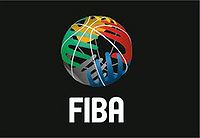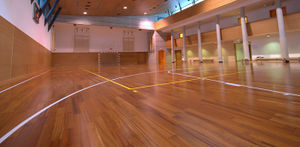
The International Game Now imagine the hardwood floor that just got waxed squeaky clean and you can just see your reflection clearly. Let’s not forget those fresh shoes with the new car smell ready to be laced up. The players that are running sprints up and down the court to have their legs warmed up. The crowd is screaming their hearts out for their favorite player every single individual is passionate about their team and roars to show whose team is the winning side. And to think FIBA (The International Basketball Federation) isn’t looked at as competitive compared to the NBA (National Basketball Association). Every player has their own ritual of getting in the “mode”. For example, Kobe Bryant for the Los Angeles Lakers shows up to the Staples Center three hours prior to game time. His motive for this is to get some shots up and make sure mentally his head is in the game. The mode to any player is the motivational point to help them focus on the game. The less distractions means the better the player perform on the hardwood floor. In this paper I will discuss what the NBA season is about as well the FIBA season. How the NBA playoffs system works compared to the FIBA league playoffs. How the FIBA league got started. I will also touch on how competitive the FIBA league is. Also, I will discuss the hardships of culture shock that American player Brandon Jennings went through while being overseas using the U- curve chart. Also how retired NBA player Yao Ming made his transition with culture shock to America. I will touch on the re-entry shock experiences Yao endured using the Re-Entry W-Curve."
'The Basic Numbers'
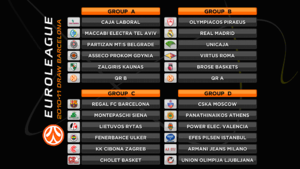
How many folks do you know that wants to make it to the NBA league? According to Scoop Jackson a sports writer for ESPN “Page 2” less than one percent makes it pro.[[1]] The exact percentage of this is .03 three out of every 10,000 male high school player will be drafted into the NBA. And that’s not even counting the foreign players that want to join the NBA league. The strongest international basketball league is the Euroleague. There are other basketball leagues in Europe such as Eurocup, Adraitic League, VTB, and League. The Euroleague is considered the European equivalent of the NBA. It consists of 24 teams, with playoffs and a championship. The best players in Europe play in this league and the NBA heavily scouts it. There are about 350 players in the league roughly. Now, 85 percent of them are African Americans so we can say that there are about 300 players that are African American professional basketball players. Does this mean the league only has the top 350 players in the world who are more competitive than anybody else? Those who don’t end up making it to the NBA league after college or just trying out for a team workout go play international."
Simply Brandon International countries recruit heavily especially if the player was a star in college but just didn’t have it took to make it in the NBA league. The reason for them recruiting in the United States they know there are competitors that won’t get the chance to play in the NBA but still can compete at a high level. For example, Brandon Jennings of the Milwaukee Bucks skipped college and went straight overseas in order to gain experience on the international level and low scoring academic abilities to get into a four year college.. In the article “''Exchange Student''”[[2]] by Chris Broussard he asked him what were the difficulties of living overseas? “Everything is tiny. The bed looks like it could be palmed by Shaq. The room is the size of a Hummer. The hotel looks like a town house.” It doesn’t sound too pleasant from the sound of it. But, in order to compete at the highest, one must experience difficulties. Although, the NBA had already changed the rules about entering from high school; Brandon was persistent to make it professional. Andrew Bynum of the Los Angeles Lakers was the last player to enter into the league after high school back in 2005. The NBA commissioner David Stern stated in a post conference interview led by Ryan Ward “With this rule, no players are allowed to come directly out of high school straight to the pros.” When this rule came into action, players would end up going overseas, playing in the D-League, and going to college. With that being said Brandon Jennings headed to Folgaria, a pristine little ski village high in the mountains of northern Italy. In order to make a name for himself to be a potential draft pick for the NBA he made sure that his hard work would pay off. Brandon also stated “This sure ain't LA. It’s culture shock and a hoops reeducation to boot. "It's tough, I'm not going to lie," says Jennings while eating pizza between practices. "I don't see many kids coming over here to do this. All that stuff about trendsetting? I don't know about that. You really have to be mentally tough."
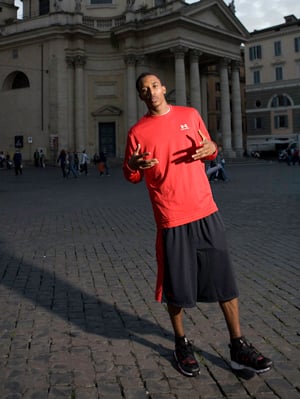
The History Behind the FIBA League Let’s take a closer look at the FIBA league.[[3]] After several failed attempts to establish an independent international federation for just basketball, the first International Basketball Conference (FIBA) was held June 18, 1932. According, to the “IAHF Technical Commission for Basketball” at the first conference the FIBB league was formed with eight national basketball associations among the original founders of FIBB -- Argentina, Czechoslovakia, Greece, Italy, Latvia, Portugal, Romania and Switzerland. Many of the players in the league are international. At an extraordinary rate the competition began to grow and became recognized even by the NBA (National Basketball Association). However, the United States didn’t get added to the league until late 1934. When the FIBA league started gaining more popularity, the countries Austria, Belgium, Egypt, Estonia, France, Germany, Poland, and Spain were added as well. Over the years the FIBA league is still growing with popularity with more passion than imagined from the fans that support the international game."
An NBA Experience
Now when you look at the NBA you see your favorite players like Kobe Bryant, Tim Duncan and Paul Pierce who are all going into the Hall of Fame. The game is so favored overseas because the American players can perform at such a high level. Everything from dunks, ankle-breakers (cross-overs), and assists makes what the NBA is.[[4]] The players endure a very long 82 game season. The season consists of 41 home games as well away games. That’s just the regular season though; playoffs are a completely different bracket. The teams with the best record are automatically deemed division champions. Also the team gets a guaranteed spot in the playoffs. This guarantees that the division champions will be no lower than fourth seed, and also ensures that a conference's two best teams (by record) are ranked as the top two. In other words the teams with the best record clinch the number one spot in their division. However, just because one team might not have the best record does not mean they aren’t capable of playing a top seed for the championship. For example, the last seed Golden State Warriors back in the 2008 season knocked off the number one seed Dallas Mavericks in the first round of playoffs. This first round of playoffs was a major disappointment to the Dallas organization. It just goes to show that the underdogs of the league matter just as much as the much expected teams that play.
 Fig 5:Dallas Mavericks vs.Golden State Warriors
Fig 5:Dallas Mavericks vs.Golden State Warriors
Being that the FIBA league is slightly different from the NBA league, so is the playoff bracket. There are a total of sixteen teams that are entered in the playoffs. However, there are two championship games. One of the games is for the bronze medal and the other for the gold. The two teams that compete for the bronze medal are usually the teams that didn’t have enough wins during the Euro Olympic season to be placed in the gold medal bracket. But they are still competing hard for the “second” place trophy for their country. The other two teams that are competing for the “first” place trophy end up being the teams with more wins during the season. Every player competes in each game like there is a first place trophy. Although, the NBA has only one trophy to compete for the two leagues still split teams based on game wins during the season. Usually the last seed plays the first seed of the division. In this case in the FIBA league the teams are randomly asserted to make the game even. Assuming that the worst teams end up playing each other due to this system is a risk, but since there is a total of sixteen teams its not to likely.
One Big Giant
One international player that was highly recognized in America but looked at as an emergence in China was Yao Ming. Yao was the first number one NBA draft pick to come from an international basketball league. Around this era it was rare for international players to be a first round draft pick. In the 2002-2003 season Yao wanted to prove that he was a top competitor in the NBA league. He was being ranked as one of the league top big man. Not too many big can lead the league in blocked shots and rebounds at the same time. The competitive nature that he possessed was recognized instantly. A true sensation back in China he became an instant marketing icon ready to ensure global connects with China. In the article “Yao Ming: NBA Giant Is Big in U.S., Bigger in China” by Brian Handwerk Yao was asked by “Ultimate Explorer”[[5]] how it felt to be China’s sense of hope as well as of Asia’s. "All of the Chinese people, the Asian people say, 'Oh Yao Ming, you are all the Chinese, all of Asia's hopes,” "That's a lot of pressure," he said. "I'm just a basketball player." The culture shock alone being in America away from his family was hard enough. Now going back home he had a weight on his shoulder as a Chinese icon for his country to have hope. Yao Ming parents both played for the Chinese national teams. It’s not hard to see that he came from athletic family members that prep him for sports. Even he was younger he even played basketball and resided at a state-run facilities for elite athletes. It was here where he learned to master his footwork, shooting ability, and defensive techniques. Just think of it as a camp that breeds basketball players that develop a true love for the game. Lisa Ling, the [“Ultimate Explorer”] television host that profiled Yao Ming said that “in the U.S., Yao lives inside a media crucible few others experience.” He’s probably one of the most swamped people in the world," said Ling. "The press follows him everywhere. I've been out with Brittany Spears and other huge celebrities, but no one has gotten the kind of attention that Yao has. It's incredible. He can't exactly put on a hat and glasses and sort of blend into the crowd." A major culture shock experience because back home Yao wasn’t had a sense of stability, privacy, and comfort back in China. When he made it to stardom back home, he even got a re-entry shock. The feeling that everything is different and folks just don’t quite understand why he felt this way.
![200px]center](/w/images/c/c5/Yao-Ming.jpg)
Culture Shocks Perspectives
Brandon and Yao both share similar culture shocks because it was completely new experiences in countries. Brandon’s new experience being over in Europe was alike to the U- curve chart that describes experiencing a new culture. According to Schneider and Barsoux the initial stage of elation and optimism “The Honeymoon Stage” is where the individual will overlook minor problems and look forward to learning new things. In this case Brandon was nationally ranked as one of the top point guard in high school. The assumption that he could go to just about any school crossed his mind but he wanted to make a name for his self. He wanted to experience something different. “Cultural differences are seen as charming and merely the positive aspects of this different culture are identified” (Schneider and Barsoux p.5). Brandon was eager to get out of the United States. The crisis experience that he went through is when began to miss his loved ones back home. Being eighteen across the globe can be nerve wrecking. In the U-curve chart this is describe as the “Frustration” portion of this new journey endured. As he began his new season as an international player he starts to realize he can handle this new adventure. The “Adjustment” where is learning new social and cultural norms. The only thing is what if his season doesn’t go the way he wants it to. The game of basketball isn’t as fun to him anymore because he doesn’t have the comfort of his family by his side. Or he just might not be scoring the way he wants to be. This period of “Mastery” can best be described as one of combination. At this point Brandon is realizing that the new culture has much to offer and develops a sense of dual cultural identity. In the article “Culture Shock” by Ashim C. Uwaje it’s called “biculturalism” at this point Brandon accepts the new culture, feels integrated and even absorbs the habits of the new society which in return makes him feel secure in his position. Summing up the symptoms of culture malaise we can evidently see that they can appear in form of various different emotions (Wagner, 1996, p. 13).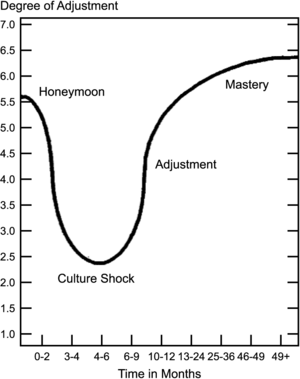
See also
- [[]]
- [[]]
- [[]]
Interwiki links
- Wikipedia:
- []
External links
- []
[[Category:]] [[Category:]]
